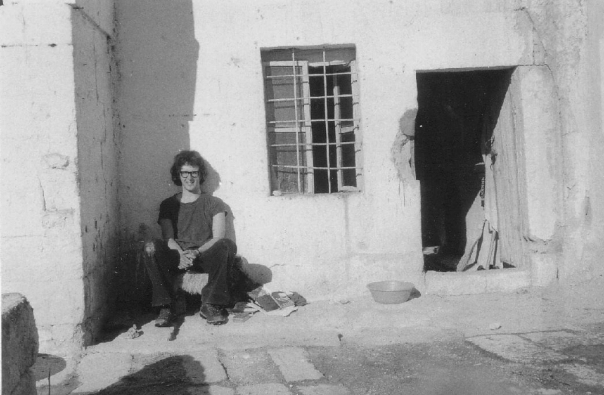
That’s me in the photo… many, many moons ago.
Bonus points for spotting the novel by Albert Camus.
I’m sitting outside a converted Byzantine chapel, carved out of a mountainside in central Turkey. I lived in that chapel for over a year. (Whole different story.)
When I was lying in bed – a thin mattress stuffed with straw on the stone floor – I could see faint frescoes painted on the arched ceiling above me.
I would lie there, thinking of the people who had carved the chapel out of the solid rock, and painted the ceiling with those frescoes.
It’s hard to be exact about the date, but I believe the chapel dated from the 8th century. Well over a thousand years ago.
While art might not last forever, a thousand years and more counts for something. And those frescoes are positively young when you compare them to the paintings in the caves of Lascaux, France, which were painted about 17,000 years ago.
The point being, while we are separated from the artists by thousands of years, we can still connect with their art. We understand what we see. We still have cultural touchpoints that connect us… whether it be about religious beliefs or hunting for food.
The art survives, not just in its physical form, but also as a way to pass whispers about our cultures from one generation to the next.
What about digital art and NFTs… are they permanent?
We have the technology to keep permanent records of digital art. Whether we’ll survive another 17,000 years, and be able to access the storage media, is a whole different story.
But let’s say people can access the NFT art of 2022 in just 1,000 years… what will they think of it? Will it still have meaning?
I hope so.
It’s nice to imagine art historians of the future curating the very best of the early years of NFTs.
Perhaps they’ll see connections between our cultural memes and some of their own. Maybe they’ll have exhibitions of early generative NFTs in the same way we hold exhibitions of the art of Egypt from the times of the Pharaohs.
But today’s pfp projects… will they also endure for a thousand years?
I have no idea.
First, I’m going to assume that most pfp projects will fade into obscurity within just a few years.
If CryptoPunks, Bored Apes and future blue-chip pfp projects are going to endure for decades or more… beyond just being cultural curiosities… they’ll need to find a permanent place in our lives and our cultures, like mainstream art. They need a role and a meaning.
I’d speculate that a select few, over the long term, will find meaning as art, as avatars in the metaverse, or as collectibles, like stamps or baseball cards.
The key question is… with their respective communities endure for millennia?
The way I see it, the greatest strength… and vulnerability… of NFTs are the communities that support them.
For art, we already know that our communities are strong. A global community of art lovers has been around for hundreds of years. Thousands even. I don’t see that changing. In fact, the rise of NFT art has massively increased the size of our community. Not every NFT art community plays nice, all of the time, but most survive their ups and downs.
I think the communities that support pfp projects are far more vulnerable. We’ve already seen communities that lose heart, or fight, or fragment or simply fade away. And when the community fades, awareness of and interest in the pfp project fades too.
So… will the Bored Ape community last 1,000 years? Many Ape owners will say yes, without question. But I’m not so sure.
On a more optimistic note, I think everything changes if the promise of the metaverse comes to fruition.
A huge metaverse with millions of citizens could provide a permanent home for both NFT art and pfps.
I’d simply dress up my pfp avatar to attend a local metaverse gallery opening, and wander around enjoying the art.